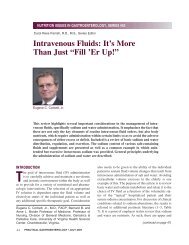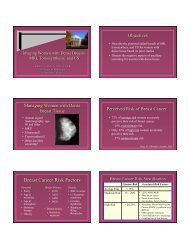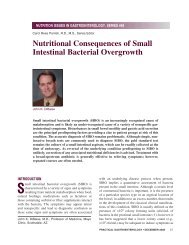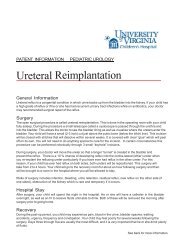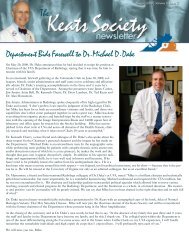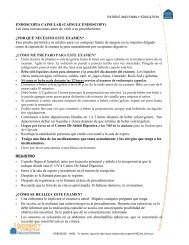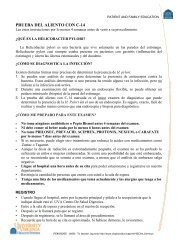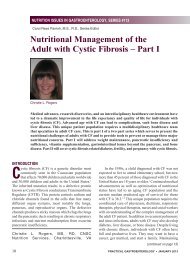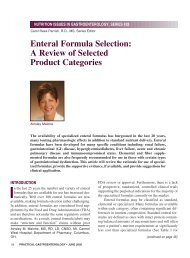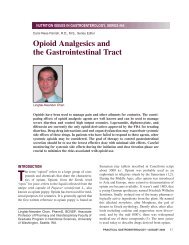Teaching The Trainer: How To Give Feedback - Medicine
Teaching The Trainer: How To Give Feedback - Medicine
Teaching The Trainer: How To Give Feedback - Medicine
You also want an ePaper? Increase the reach of your titles
YUMPU automatically turns print PDFs into web optimized ePapers that Google loves.
<strong>How</strong> to <strong>Give</strong> <strong>Feedback</strong><br />
Linda A. Waggoner-Fountain, M.D.
I have no disclosures to state. I do have my<br />
own opinions.
Learning Objectives<br />
• In this workshop, we will<br />
– Review basic principles of effective feedback.<br />
• Following this session, participants will be able to:<br />
– Describe what feedback is and what it is not<br />
– Describe how and when to give feedback<br />
– Develop skills in giving feedback<br />
– Recognize the importance of providing feedback.
<strong>Feedback</strong> - Definition<br />
Interactive process aimed at<br />
reinforcing positive behavior and<br />
providing specific guidelines for<br />
future behaviors<br />
“corrective” – negative<br />
“reinforcing” – positive
Characteristics of Good <strong>Feedback</strong><br />
• Video
<strong>Feedback</strong> – Why is it important?<br />
• <strong>Feedback</strong> is central to medical education<br />
in:<br />
– promoting learning<br />
– ensuring that standards are met<br />
• Provides:<br />
– Student/resident with an accurate perception<br />
of their own performance<br />
– Enhanced student/resident self awareness
Room for improvement<br />
• Residents report feedback is not common<br />
– In one study, only 8% of residents were “very<br />
satisfied” with feedback process<br />
• “Corrective” feedback much less common than<br />
“reinforcing” feedback<br />
– Reinforcing feedback<br />
• Never or infrequently receiving 17%<br />
• Sometimes receiving 52%<br />
• Often receiving 34%<br />
– Corrective feedback:<br />
• Never or infrequently receiving 80%<br />
• Sometimes receiving 20%<br />
• Often receiving 0%<br />
Isaacson et al 1995
<strong>Feedback</strong>? Coaching?<br />
Performance Evaluations?<br />
<strong>Feedback</strong> Coaching Performance<br />
Evaluation<br />
Purpose <strong>To</strong> reinforce or<br />
change behavior<br />
Participants Any ≥ 2 people Typically supervisor to<br />
direct report but can be<br />
multidirectional<br />
Place Private and quiet<br />
space<br />
<strong>To</strong> improve skills <strong>To</strong> evaluate past work<br />
Depends on the skill to<br />
be learned<br />
<strong>To</strong>ne Casual, can be formal Somewhat formal, but<br />
potentially relaxed<br />
Timing Impromptu prn or<br />
during formal<br />
sessions<br />
Supervisor to direct<br />
report<br />
Usually in the<br />
supervisor’s office<br />
formal; often stressful<br />
Regular meetings Scheduled, e.g. q 6<br />
mos or yearly<br />
Follow-up Continual Continual Based on action plan
Obstacles for Teachers<br />
• It can be uncomfortable giving negative<br />
feedback<br />
• Concerns about consequences of negative<br />
feedback<br />
• Time constraints<br />
• Poor feedback skills<br />
• Unaware of the importance of feedback<br />
• Limited knowledge about the performance
Obstacles for Receiving Effective<br />
<strong>Feedback</strong><br />
• Perceived as personal judgment<br />
• Inconsistent messages<br />
• Inappropriate environment<br />
• Different goals<br />
• <strong>To</strong>o busy
What Are <strong>The</strong> Critical<br />
Elements In <strong>The</strong> <strong>Feedback</strong><br />
Process?
Critical Steps<br />
1. Orientation and Climate<br />
2. Elicitation<br />
3. Diagnosis and <strong>Feedback</strong><br />
4. Improvement Plan<br />
5. Application<br />
6. Review
Study<br />
• Study: Clinician teachers’ personal experiences during a<br />
course for improving teaching of medical interviewing<br />
– 83 physicians/scientists from 60 centers (US, UK, Canada)<br />
– Select population of enthusiastic, motivated, talented, intelligent,<br />
energetic people asking for feedback of simulated settings<br />
• 1 week course; small groups of 5 with facilitator<br />
– Six 2-hour training sessions, simulated patients, etc<br />
– Encounters discussed in working groups<br />
• <strong>Feedback</strong> on feedback<br />
– Qualitative (narratives) and quantitative (semantic differential<br />
ratings of different techniques)<br />
Hewson MG, Little M, J Gen Intern Med 1998;13:111-116
Critical Steps<br />
1. Orientation and Climate<br />
2. Elicitation<br />
3. Diagnosis and <strong>Feedback</strong><br />
4. Improvement Plan<br />
5. Application<br />
6. Review
Method of feedback
Method of feedback
Timing of feedback<br />
• Ideally, schedule/prepare person for session<br />
– e.g. at end of first week of rotation, quarterly, after<br />
code or difficult procedure<br />
– Clarify why you are giving feedback<br />
– If delayed = “advice”<br />
• Allow resident self-appraisal<br />
• Defuse emotionally charged situation<br />
• Immediate – constructive criticism<br />
• Logical, practical (prevent recurrence; unique)<br />
• Avoid emotionally charged situation
Critical Steps<br />
1. Orientation and Climate<br />
2. Elicitation<br />
3. Diagnosis and <strong>Feedback</strong><br />
4. Improvement Plan<br />
5. Application<br />
6. Review
Method of feedback
2. Elicitation<br />
• Ask recipient about their goals<br />
– “What are/were your goals for this rotation?<br />
• Ask person for self-assessment<br />
– “<strong>How</strong> do you think it went?”<br />
– “What did you do well?”<br />
– “What could be improved?”<br />
– “<strong>How</strong> did it go for you?”
Critical Steps<br />
1. Orientation and Climate<br />
2. Elicitation<br />
3. Diagnosis and <strong>Feedback</strong><br />
• Content of the feedback<br />
4. Improvement Plan<br />
5. Application<br />
6. Review
Content of feedback
Content of feedback
3. Focus on specific observations<br />
• Sometimes forced to resort to “practical”<br />
feedback (esp. if there’s a pattern)<br />
– e.g. “<strong>The</strong>re’s a perception by some of the<br />
support staff that… When you go out into<br />
practice, you cannot afford to be perceived<br />
as…”
Content of feedback
Difficult<br />
Easy<br />
Job Skills Time and Work<br />
Management<br />
HELPING PEOPLE CHANGE: EASY TO DIFFICULT<br />
Know ledge Attitude Habits Personality<br />
Characteristics
3. Content of feedback<br />
1. Based on your observations ideally<br />
2. Based on specific actions<br />
3. Based on behavior, not personality
Content of feedback
3. Steps to goal-based feedback<br />
• You respond to the self-assessment<br />
• And explain your responses in context of<br />
shared goals
Method of feedback
4 Methods of <strong>Feedback</strong><br />
• Sit-Down One-on-One <strong>Feedback</strong> Model<br />
– <strong>Feedback</strong> Sandwich or Oreo Cookie<br />
• <strong>Feedback</strong> on the Fly Model<br />
– Open-faced Sandwich
4 Methods of <strong>Feedback</strong><br />
• Start, Stop, Continue Model<br />
– Start – What learner needs to start doing<br />
– Stop – What learner needs to stop doing<br />
– Continue – What learner should continue<br />
doing<br />
• Agenda Led, Outcome-based Analysis<br />
– ALOBA model
Agenda Lead, Outcome-Based<br />
Analysis – ALOBA model<br />
• Self assessment by learner to acknowledge what was<br />
done well<br />
• What was done well reinforced by the teacher<br />
• Skills used to achieve successful outcomes discussed<br />
• Self-assessment by learner – what could have been done<br />
better – analyses alternatives skills<br />
• Facilitator suggests alternative skills if necessary<br />
• Learner feedback to the facilitator - content of feedback<br />
and skills
Critical Elements<br />
1. Orientation and Climate<br />
2. Elicitation<br />
3. Diagnosis and <strong>Feedback</strong><br />
4. Improvement Plan<br />
5. Application<br />
6. Review
Method of feedback
4. Improvement Plan<br />
• Invite person’s suggestions<br />
– “<strong>How</strong> do you think it could have gone<br />
differently?”<br />
• Ask again about goals<br />
– “Have your goals changed?”<br />
• <strong>Give</strong> your suggestions/Teach<br />
– “This is my suggestion:”<br />
• Consider identifying a coach
Critical Elements<br />
1. Orientation and Climate<br />
2. Elicitation<br />
3. Diagnosis and <strong>Feedback</strong><br />
4. Improvement Plan<br />
5. Application<br />
6. Review
5. Application<br />
• Apply planned improvements/strategies to<br />
current or future problems<br />
– “What will you do next time?”
Critical Elements<br />
1. Orientation and Climate<br />
2. Elicitation<br />
3. Diagnosis and <strong>Feedback</strong><br />
4. Improvement Plan<br />
5. Application<br />
6. Review
6. Review<br />
• Person reviews performance, behaviors,<br />
including any that need change<br />
– What do you do well?<br />
– What changes will you make?<br />
• Reaffirm person’s worth and ability to<br />
correct their behavior<br />
– “I am confident that you’ll be able to…”<br />
• Schedule follow-up (when applicable)
Critical Elements<br />
1. Orientation and Climate<br />
2. Elicitation<br />
3. Diagnosis and <strong>Feedback</strong><br />
4. Improvement Plan<br />
5. Application<br />
6. Review
Small Group Cases<br />
• Work in pairs or trios<br />
• Pick 2 cases<br />
• Focus on the feedback language you<br />
would use
Don’ts<br />
1. Don’t email feedback (esp. negative)<br />
• No opportunity for orientation, elicitation<br />
• No opportunity to clarify the facts<br />
• Impersonal<br />
• No way to control tone or modify conversation<br />
2. Try not to give feedback when angry<br />
• Think about the timing of your feedback<br />
3. Don’t be accusatory, demeaning or sarcastic<br />
4. Avoid negative feedback in front of<br />
peers/patients<br />
5. Think about post call/up all night issues
Take Home Points<br />
• Tell the person that you are going to give<br />
them feedback<br />
• Engage the learner in the process – self<br />
assessment<br />
• Focus on behaviors – what needs to be<br />
changed<br />
• Develop an action plan
• Hilary Sanfey<br />
• Ted Burns<br />
• Nancy McDaniel<br />
• Casey White<br />
Acknowledgements<br />
• <strong>The</strong> patients, students, residents &<br />
colleagues I have worked with over the<br />
past 20 years.
Suggested Reading<br />
• Sachdeva A. Use of effective feedback to facilitate adult<br />
learning/ Journal of Cancer Education 1996;11:106-118<br />
• Salermo et al. Faculty development seminars based on<br />
the one minute preceptor improve feedback in the<br />
ambulatory setting. JGIM 2002;17(10):779-787<br />
• Spickard A. Words hard to say and hard to hear ”May I<br />
give you some feedback?” JGIM 1998;13(2):142-143<br />
• Hewson M et al. Giving feedback in medical education:<br />
verification of recommended techniques. JGIM<br />
1998;13(2): 111-116
Suggested Reading<br />
• Gil et al. Perceptions of medical school faculty<br />
members and students on clinical clerkship<br />
feedback. J Med Educ. 1984; 59:856 – 864<br />
• Irby et al. Factors affecting ratings of clinical<br />
teachers by medical students and residents J<br />
Med Educ 1987;55:1-7<br />
• Isaacson JH et al Resident Perceptions of the<br />
evaluation process. Society of General Internal<br />
<strong>Medicine</strong>. J Gen Intern Med 1995;10(suppl):89



